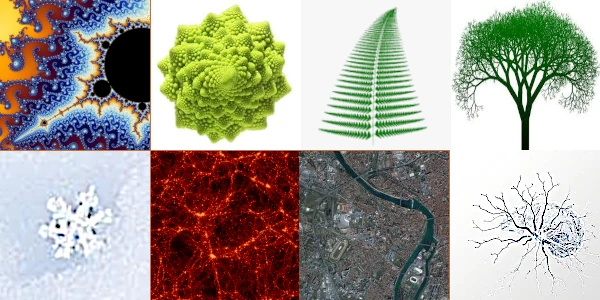
A fractal is a geometric structure possessing the property of self-similarity: each portion, regardless of the scale of observation, resembles the whole. This property finds a striking expression in mountain reliefs, river branches, pulmonary and neural networks, and even in the distribution of galaxies in the observable universe.
The fractal imprint is omnipresent in nature. Fractals are complex, self-similar geometric structures found everywhere in nature. Their pattern repeats at different scales, creating both irregular and harmonious shapes.
Fractals reveal a fundamental principle of nature: the ability to generate complexity from simple rules. These natural structures share an essential property: self-similarity or the recurrence of patterns at different scales. This emergence of order from chaos is a visible manifestation of complex physical processes self-organizing.
These natural forms show that fractals are not just abstract: they are fundamental in the organization of the living and physical world.
| Structure | Description | Scale | Type of Fractality |
|---|---|---|---|
| Galaxies | Spiral arms and clusters show a fractal organization on a large scale, up to 500 Mpc. | 10⁴ to 10⁸ light-years | Statistical (hierarchical distribution) |
| Cloud Structures | Self-similar contours, influenced by atmospheric turbulence. | 10 m to 100 km | Physical (turbulence, energy cascade) |
| Blood Flow | Branched network of arteries and capillaries optimizing diffusion. | µm to m | Biological (optimization network) |
| Neural Networks | Dendritic branches maximizing connections and information processing. | µm to cm | Biological and Functional |
| Breton Coast | Irregular geometry revealing an increasing length as you zoom in. | 1 to 1000 km | Geomorphological |
| Lungs | Branching of the bronchi to the alveoli: 23 fractal generations. | mm to 30 cm | Biological (maximal surface/volume) |
| Bacterial Colonies | Growth in dendritic patterns on poor substrates. | mm to cm | Diffusion-limitation |
| Mountains and Reliefs | Persistent roughness over several orders of magnitude. | 10 m to 1000 km | Geophysical (erosion, deposition, tectonics) |
| Snowflakes | Hexagonal dendritic crystallization sensitive to temperature and humidity. | 0.1 to 10 mm | Physical (growth instabilities) |
| Spider Webs | Regular spiral patterns with geometric recurrence. | cm to tens of cm | Functional Bioconstruction |
| Romanesco Broccoli | Pyramidal spirals following the Fibonacci sequence. | cm to dm | Visible Vegetal Fractal |
| Ammonites | Fossil shells in equiangular logarithmic spiral. | cm to tens of cm | Natural Geometric |
| Other Examples | Ferns, lightning, river networks, corals, urban formations. | µm to km | Multidisciplinary |